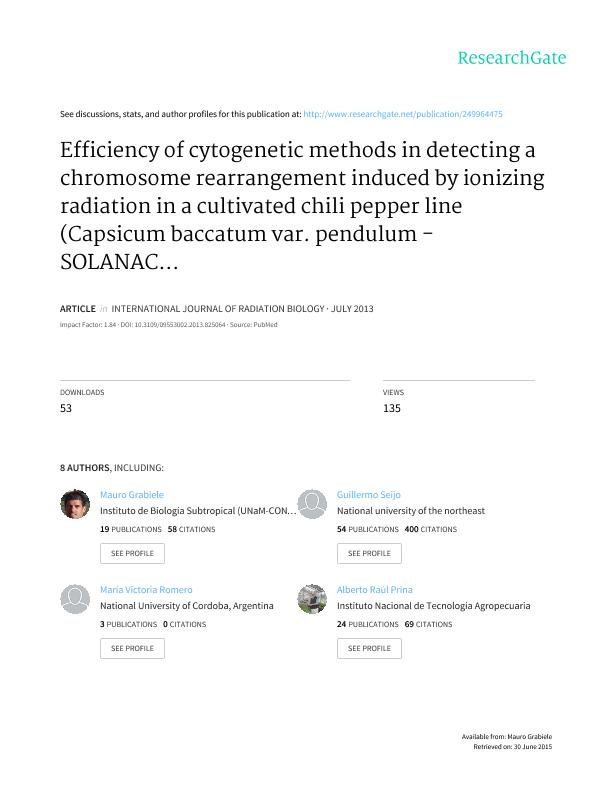Artículo
Efficiency of cytogenetic methods in detecting a chromosome rearrangement induced by ionizing radiation in a cultivated chili pepper line (Capsicum baccatum var. pendulum-Solanaceae)
Scaldaferro, Marisel Analía ; Grabiele, Mauro
; Grabiele, Mauro ; Seijo, Jose Guillermo
; Seijo, Jose Guillermo ; Debat, Humberto Julio
; Debat, Humberto Julio ; Romero, María Victoria
; Romero, María Victoria ; Ducasse, Daniel Adrián; Prina, Alberto Raul; Moscone, Eduardo Alberto
; Ducasse, Daniel Adrián; Prina, Alberto Raul; Moscone, Eduardo Alberto
 ; Grabiele, Mauro
; Grabiele, Mauro ; Seijo, Jose Guillermo
; Seijo, Jose Guillermo ; Debat, Humberto Julio
; Debat, Humberto Julio ; Romero, María Victoria
; Romero, María Victoria ; Ducasse, Daniel Adrián; Prina, Alberto Raul; Moscone, Eduardo Alberto
; Ducasse, Daniel Adrián; Prina, Alberto Raul; Moscone, Eduardo Alberto
Fecha de publicación:
08/2014
Editorial:
Taylor & Francis
Revista:
International Journal Of Radiation Biology
ISSN:
0955-3002
Idioma:
Inglés
Tipo de recurso:
Artículo publicado
Clasificación temática:
Resumen
Purpose: To locate transient chromosome aberrations on a selected pepper cultivar and determine the tracing efficiency of different cytogenetic methods.
Materials and methods: Seeds from Capsicum baccatum var. pendulum cultivar ‘Cayenne’ were treated with an acute dose of X-rays (300 Gy) and chromosome aberrations were analysed by different cytogenetic methods [Feulgen, silver staining for nucleolus organizer regions (silver positive nucleolus organizing regions or AgNOR), fluorescent banding, fluorescence in situ hybridization (FISH) and meiotic analysis].
Results: A rearranged chromosome carrying two nucleolus organizing regions (NOR) induced by ionizing radiation was detected in the cultivar, with the occurrence of a small reciprocal exchange between a chromosome of pair no. 1 and another chromosome of pair no. 3, both carrying active NOR in short arms and associated chromomycin A positive/diamidino-phenylindole negative (CMA+/DAPI−) heterochromatin. Meiotic analysis showed a quadrivalent configuration, confirming a reciprocal translocation between two chromosomes.
Conclusions: The use of X-rays in Capsicum allowed us to develop and identify a pepper line with structural rearrangements between two NOR-carrying chromosomes. We postulate that all the cytological techniques employed in this research were efficient in the search for chromosome aberrations. Particularly, Feulgen and AgNOR were the most suitable in those cases of transient rearrangements, whereas fluorescent banding and FISH were appropriate for intransitive ones.
Palabras clave:
Capsicum
,
Ionizing Radiation
,
Chromosome Aberrations
,
Cytogenetic
Archivos asociados
Licencia
Identificadores
Colecciones
Articulos(CCT - CORDOBA)
Articulos de CTRO.CIENTIFICO TECNOL.CONICET - CORDOBA
Articulos de CTRO.CIENTIFICO TECNOL.CONICET - CORDOBA
Articulos(IBONE)
Articulos de INST.DE BOTANICA DEL NORDESTE (I)
Articulos de INST.DE BOTANICA DEL NORDESTE (I)
Articulos(IMBIV)
Articulos de INST.MULTIDISCIPL.DE BIOLOGIA VEGETAL (P)
Articulos de INST.MULTIDISCIPL.DE BIOLOGIA VEGETAL (P)
Citación
Scaldaferro, Marisel Analía; Grabiele, Mauro; Seijo, Jose Guillermo; Debat, Humberto Julio; Romero, María Victoria; et al.; Efficiency of cytogenetic methods in detecting a chromosome rearrangement induced by ionizing radiation in a cultivated chili pepper line (Capsicum baccatum var. pendulum-Solanaceae); Taylor & Francis; International Journal Of Radiation Biology; 90; 1; 8-2014; 104-112
Compartir
Altmétricas



